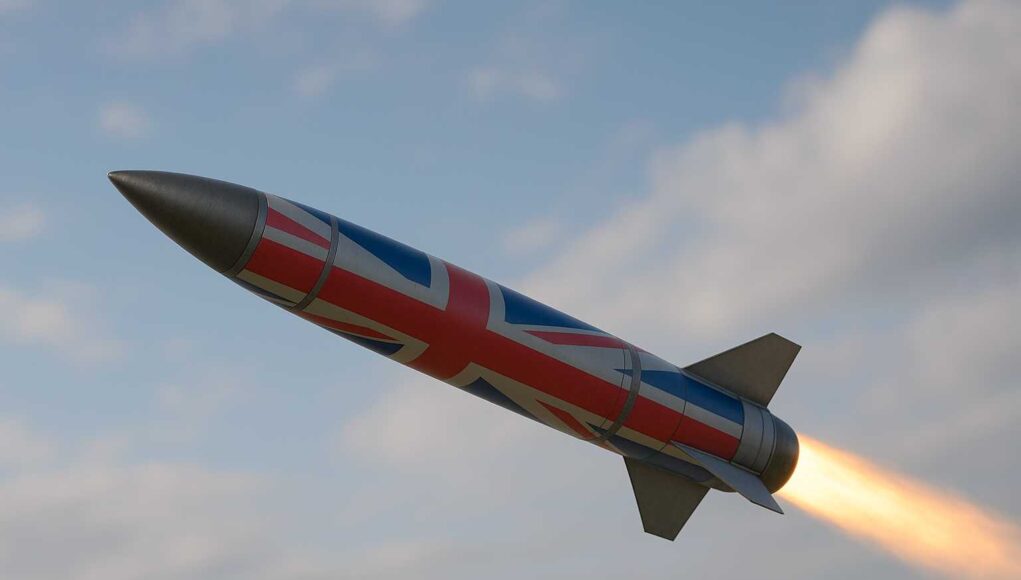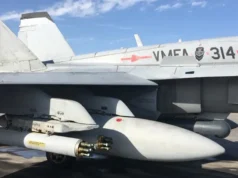The Ministry of Defence has formally revealed its intention to pursue a new ground-launched tactical ballistic missile under Project NIGHTFALL.
The requirement is at an “open early engagement” stage. Industry has until 18 September to respond before a follow-on competition is launched.
The MOD described the Single Statement of User Need (SSUN) in direct terms: “The User requires a cost-effective, tactical (>500km) ballistic missile, capable of being safely ground launched from a mobile platform in a high threat tactical environment, navigating to and accurately striking a user-programmed co-ordinate.”
The document emphasises that the missile must be operable in harsh conditions: “It shall be operable in harsh physical environments, day and night, of low multispectral signature, resilient in a complex Electromagnetic environment (EME), including within a GNSS denied & degraded environment, and resistant against targeted EW attack and spoofing.”
The published specifications set out a demanding baseline:
Range: more than 500km on a ballistic trajectory
Payload: around 200kg of high explosive per effector
Accuracy: CEP50 of 5m, including in GPS-denied environments
Responsiveness: strike targets within 10 minutes of launch
Volume of fire: more than two missiles per vehicle, all launched within 15 minutes
Scalability: minimum output of 10 missiles per month, with capacity to expand
The MOD also stipulated a target price: “The target effector cost is £500,000 all-up per unit, excluding the warhead, launcher and any development costs.”
The aim is not just to field a new missile but to do so at speed. “The aim is to deliver this product at pace, which means there is an aggressive timeline of a demonstration firing in circa 9 months from any contract award and serial production approximately 3–6 months later, producing a minimum of 10 units per month.”
The requirement states that multiple missiles must be delivered from a single mobile launcher. “MOD requires the ability to deliver multiple (>2) effectors from a single ground vehicle,” the notice explains. The vehicle must be able to halt, fire all effectors within 15 minutes, and then leave within five minutes of the final launch to avoid counter-fire.
Flight profiles must be fast, with a time-to-target of less than 10 minutes. Each effector should also demonstrate “some basic manoeuvrability” while retaining the cost ceiling and accuracy standards.
The MOD has clarified what will and will not be considered. Acceptable solutions include complete missiles or contributions in specific categories such as propulsion, airframe, navigation, scalable manufacturing, mobile launcher systems, or systems integration. Prototype systems are permitted if they can be developed to test-ready status within nine to twelve months.
By contrast, the notice warns that proposals will not be accepted if they involve “solutions exceeding target prices, drones or other effectors that do not fly in a ballistic trajectory, literature reviews, warheads, [or] products that cannot be scaled at pace/meet the timelines.”
The MOD also stated that “the project will be prioritising scalability over exquisite solutions,” making clear that mass production and rapid delivery are valued more than highly complex or expensive designs.
Some components may be provided as government furnished equipment. This includes “payload, fuzes, testing ranges/facilities, support for scaling, [and] government SME (DSTL, DE&S) advice.” The MOD further noted that designs should “minimise and ideally be free from foreign government trade and usage restrictions, such as export control,” ensuring independence from non-UK suppliers and avoiding political limitations.
Upgrade potential is also required, with the notice stating that systems must be adaptable for “increasing the range, accuracy, in-flight manoeuvrability, fitted telemetry and other elements as required.”
To support the launch of Project NIGHTFALL, an industry day will be held in London on 24 September 2025. Attendance will be limited to two representatives per company, with one permitted if capacity is exceeded. Responses must be submitted by 18 September.
The MOD is encouraging collaboration: “MOD encourages companies to work together in a consortium to help address the full NIGHTFALL requirements.” Following this engagement, the department intends to run a competition through the Defence Sourcing Portal, narrowing down to an anticipated three proposals. These will be funded to demonstrate compliance with requirements in 2026.
With a planned 600km-plus range, 300kg payload, rapid launch and strike cycles, and mass production of ten units per month, the requirement outlines an ambitious, scalable capability. If industry feedback is positive, a competition will be launched in late 2025, leading to demonstration firings in 2026.














I still like to see these figures in in traditional figures.
Range 310 Miles
Payload 440LBS
Accuracy 3.2 miles.
Or if you take the last Paragraph,
Range 374+ Miles
Payload 660LBS.
In old money.
£500,000 per effector (only) and target of 120 per year gives £60,000,000 so plenty of money left to buy the dangerous bit and the Hi-Lux Launch Vehicle.
Accuracy figure is a bit out, I just got up !
16 ft, or there abouts.
Would be cool to have an Edit feature, I’d use it a lot !!!
Yes miss that facility. Have to say when I saw accuracy 3.2 miles it took me back to the 60s as many a casual off the cuff ‘effector’ does these days.
I was just thinking, what is this, Soviet Russia? Does it have a 20kt nuke to compensate for the”accuracy”? 😂
But no, imperial units strike again
Am disappointed you didn’t go the whole way and price the effectors in guineas and their range in cubits…
Surely Rods, Poles and Perches are the best units?
Then provide a handy conversion table to olympic swimming pools, sausages, London buses and Nelson’s column….
How many groats to the £ these days, Doubloons for that matter, Drake, Raleigh will be turning in their graves. Bloody EU.
Sorry, I’m not a Tennis fan.
Don’t be disapointed Spock, I’m waiting for the Photon Torpedo and Phaser article, Then I’ll post Warp Speed and Star date comparisons just for you.
If you look behind, you might just see a Klingon, de-cloaking or It might just be Flash Gordon.
4,910,400 hands
The CEP is for 50%+ to land within 5 meters/6 yards of the target.
2.2 lbs to the kg so 200kg is 440 lbs !
That’s what I put, then I saw the range had increased in the last paragraph !
To be fair though, I’d just got up !
Why? if it ground launched MLRS A2 can do this already,(depending on ammo type). I like the idea of it and home built would be way better than being ripped off by the Yanks, just not sure what gap it fills and what might launch it. Will it be hyper sonic? it will need to to be. A testable round in under a year, ha ha nothing the MOD does take less than 3/5/10 years and way over cost.
Ground base ballistic defence would be a good idea and or Hyper missile defence.
Move away from reliance on the US, who has demonstrated to be an unreliable ally
Or on the flip side, a fudge procement process with requirements designed to guarantee that the existing platform that they intend to buy wins it. Been done many times before.
The unreliable ally is the UK. It’s the UK that deliberately allowed its Armed Forces to atrophy so that it can contribute very little relative to its size thus increasing the burden on a US that has consistently maintained its commitments to NATO. I guess 10,000 airmen and three of the best jet fighter squadrons in the world stationed on British soil defending the UK makes the US unreliable. Perfidious Albion.
🥱
Thanks for the update yank.
Anytime. And the truth shall make you free, Limey.
Umm you do realise the US economy is about 8-10 times the size of the UK so if we scale
Carriers 2 x10 =20 ummm
Large surface combatants 14x 10 =140 umm does the US have 140 large surface combatants?
SSN 7×10 =70, clue you dont have 70 SSNs
SSBNs 4 X10 =40
Fighter jets 160ish x 10 =1600
MBTs 220 x 10 =2200
So by scale we do put down a relative capability. So take your hate and maybe direct it at the actual enemies of your nation before it to late..
Well we have on order 13 frigates and have 6 destroyers so that will be 19 real warships quite soon.
As I’ve made the point before if we went back to 24 real warships we would have about 30% of the USN fighty fleet.
TBH that might be the best way for us to go with a bigger ASW and GP fleet as that is what is needed.
Although more P8 would be quite useful too and I am not holding my breath for its drone friends and they won’t be any cheaper or better to run.
The attraction of the ‘strike frigate’ ( aka T32) is that it turns the problem of the LPDs into the opportunity of a bigger fleet of GP frigates by extending the understand of GP.
Thing is that more T31 are needed otherwise it isn’t worth the costs of full sensor integration.
So I’d hope we see another 3 T31 as well as the strike frigates….
It’s not 1 for 1. A single flight III burke has more capabilities than the entire fleet of T23’s. The US has capabilities like an entire space based recon program that the UK doesn’t ‘scale’ to.
Almost all the battlefield intelligence (more than 85%) in the Ukraine war has come from the US. It can watch the entire battlefield in real time from space.
And when it comes to hunting tracking and killing a submarine a T23 and Merlin is vastly more capable than a Burke. It is considered a reasonable assumption that an astute has a better sensor set than a Virgina, but the Virginia has a better land attack, the astute is definitely better sensor wise than the 24 old LA boats… but it’s all Willy waving to the wrong crowd.
The issue is a portion of the U.S public and administration seems to be a spiral hate with its major allies and the only people who will gain in the end are the CCP, the US and European nations really falling out is the geostrategic version of every western nation putting a gun to their right foot and shooting.., just as china is about to come for the US and Russia is pushing Eastern European nations.
Only a Brit, when confronted with reality, would characterize it as “hate.” Do you honestly believe that the UK’s Armed Forces are as capable as they were 15-20 years ago? If you do, you need medication.
The US is focusing on its real enemy, China, where the UK’s Armed Forces are of no value, including two white elephant aircraft carriers that rely on the US and Japan to fill its flight deck.
Yes the use of the word” Perfidious Albion” sets the tone on the hate. It is a term of hatred used by the enemies of the UK. I have no issue with a debate about defence cuts.. I think the UK and US along with all western nations are cutting their throats. But your tone and engagement only aids the enemies of the west.
Oh, you poor little snowflake. “Perfidious Albion” is not hate; it’s a description of what most nations who have dealt with the UK think of it. It’s reality.
The US is not cutting its throat. It’s starting to undo the damage it’s done to itself in the past 10-15 years. The UK could learn a lesson from it but it continues to arrest people for hanging a flag, praying silently, and making humorous tweets. A country where 12 year old girls have to arm themselves with tomahawks to protect themselves from grooming gangs needs to take a deep hard look at itself.
The US has secured its borders, is deporting illegal immigrants, and standing up to woke culture. The US and UK are going in totally opposite directions but your irrational hatred for “orange man bad” won’t allow you to recognize it.
PKCasimir, True that our armed forces have atrophied too much, but Britain (Cameron) set the 2% target for NATO at the 2014 conference and has always achieved that. I am not aware that the US increased their military presence in Europe during the years that Britain and other ENATO forces atrophied unless you care to enlighten us?
Perhaps your point is better directed at NATO countries that did not spend 2%?
Or maybe even the ones that have not historically supported US foreign policy even to our own detriment…..
There are also other eNATO countries that have spent and supported US foreign policy…..
You might try calling out Spain [who still refuse to go to meaningful spending] Germany who took the uber peace dividend…..
Ah, you must be Iranian then !!!
I have always suspected PKC was a political warfare bod for Russia or china, but I don’t rule out geostrategic idiocy as his posts have over the year got more and more anti UK and Europe as a core of the Republican Party has got more anti European.
Or “He” could just be a WUM with a few other handles. I don’t thing George would let a “Bot” keep posting.
I know which I believe !
(WUM, Wind Up Merchant, chooses to use the opportunity to place cats in the middle of Pigeons for the sole reason of enjoying the attention).
I’d not seen this character here for many a month. Well over a year in fact.
He pops up now and again with an anti UK rant
stop moaning I imagine they still get discounted petrol to make them feel at home
… and more worryingly the Trump Regime is going full economic Commie/National Socialist at the moment buying shares in Intel, Navidia and wanting part of Lockheed Martin and Palantir amongst others. This I fear is but the beginning. Clearly the desired policy is step by step, to control the mechanisms of internal control and as he is already attempting through tariffs and external economic policy utilising effective bribes/blackmail, using that Govt power and direct influence to leverage further control over external matters, Countries and bodies too. A Greater Trumpian Union of compliant States. If there aren’t kill switches now there certainly will be in the future weapons we expensively buy. Forcing Countries to buy American weapons as part of tariff threats now while having far greater control over the usability of those weapons in future conflict is scary to imagine. Particularly after we saw the troubled shaken look and presence of Trump and co after the Alaska fiasco while the Russians looked smug and smiling like they owned the place, well they think they do of course. Dread to think what was revealed in that meeting but not good I fear.until we know otherwise we must see Trump as a Russian asset and act accordingly whatever sickening bending the knee we see in public to polish his ego.
I would not go so far as a national socialist, it simply does not have the racial or antisemitic element, but I would say I think the U.S. is falling into a corporatists almost an Italian style fascist type state.
Essentially the merging of big corporate interests into government, authoritarian control ( using the state security apparatus on its own people) are all signs of an Italian fascist style of government.. some say it’s Trumpism but it’s starting to look and smell like a corporatist fascist state in the making.
The thing is, if we are going to spend a load of money building stockpiles of missiles then we may as well examine if that money can be spent in the UK.
We do fundamentally have the tech to produce missiles and systems like this. We have developed CAMM and other related systems.
The problem, recently, has been the tiny production volumes that MOD has been buying so making them in the UK has been outrageously expensive.
If MOD are prepared to commit to volume production [10 per month isn’t any kind of volume] then costs will fall.
More the questions is how big a stockpile we are prepared to pay for and therefore keep and to what capacity can the line scale?
Agreed if the MOD ordered more it would lower cost price but do seem to hold not that big stock piles, may be that might change. Buying from the USA has it pit falls ie they can charge what they want, supply if and when they want its money going out of the country and as with F35 they control the soft ware.
The obvious answer is nations are relearning the old lesson that uncle sam is unreliable, not least in the sense, that at the very least the price of any weapon system increases in war, while also feeling like Pinocchio with all the other strings attached.
.
.
I recall the small handed oompah having a tanty when reports of other nations weapon systems development plans were mentioned at the cost of more sales and influence coming his direction 😄. Talk about not seeing further than 6″ in front of one’s face 🤣
.
.
Cause and effect.
It says that the Industry day will be on the 24th Sep 25 and the responses must be submitted by the 18th Sep. ?
Probably about right, given the standard of some documents sent from DE&S.
Contradicting requirements, races time lines for the contractor to respond, then 6 months for MOD to comment.
Sounds like an excellent excuse to produce Ukraine’s Neptune 2 in this country. Might get some sizeable export orders from NATO?
hw. Sloppy staff work from DE&S perhaps. But usually the initial response from Industry is just an Expression of Interest.
Am I missing the obvious or context perhaps butisn’t the 18th for acknowledgement of interest to the proposal and 24th the meet up to get the low down on what’s required and discuss further? Very tight mind. It begs the further question, what form could this missile take that could be proposed let alone developed in the required time scales, what UK based manufacturers or at least uk IP (or offered IP) could be offered up to achieve it. Can’t think of any present Uk missile that could be adapted to meet this request so one presumes that indeed the Neptune or similar base missile might well be offered to fulfil it, get produced here and perhaps re supplied back to Ukraine or whoever might want it. Effectively this request would be something of a cover to get around clear hostility and threats from Russia while enabling a decent Uk built capability for ourselves. Time will tell.
18th Sept next year?
This just sounds like a requirement for PrSM dressed up in a project so some colonel can have something good on his CV before he goes off to try an get an over paid “consultancy” gig from the same defence contracts making billions from HMG.
We already announced two years ago we are buying PrSM
My first thought as well.
Is PrSM cancelled?
And who in the RA will fire it?
Until orders are placed it’s just another program that makes headlines that might go nowhere.
I was sceptical about the price target too, but I don’t really know prices so maybe it is doable.
Hi Daniele,
I wondered about the price until I read what it excluded, the launch vehicle, the warhead and critically the development costs.
One thing that got my attention is that the warhead might be GFE. So what kind of warhead?
The requirement to be able to increase range was also interesting. The easiest way to increase the range of a ballistic missile, assuming it is strong enough to take the extra loads, is to bolt a first stage booster onto it. So depending on where the range finally settles for the initial design this thing could be developed to achieve a range close to 1000km.
The real development, if successful, is the procurement cycle and the production scalability.
Cheers CR
Morning mate.
Yes, I raised my eyebrows too at the GFE bit.
Are we talking some mash up like some of the Ukrsine stuff?
Or tha ability to turn it into a tactical nuclear weapon.
Could be. Certainly the timeframe is fast and is inline with the idea that we are moving onto a war footing. If it works I’ll amazed and relieved frankly. We desperately need to speed up procurement and critically ensure that defence infrastructure keeps up with the switch into a pre-war era. Capability is dependent on more than just the technology and people. Boring stuff like space and cranes to move containers around, holes in the ground to store munitions etc.
Another option for the missile is a nuclear warhead as Jonathan suggested. That would be an obvious GFE warhead and would change the calculus in Europe.
Cheers CR
I think that is a vital option to at least put powerful doubts in the minds of Putin but perhaps more importantly those around him who may retain more caution. The Cuba crisis might have turned into full scale war perhaps nuclear war had not one Russian submarine Captain not shown such caution.
It could with that warhead weight carry a W76-2 warhead and would essentially be an excellent match to the Russian short/medium range nuclear tipped ballistic missiles..
Just the capability would be a massive deterrent to Russian first use of tactical nuclear weapons.
Hmm, that is interesting. That coupled with more than one missile per vehicle and it is looking like quite the deterrent asset. If a little scary that we are heading back to that kind of weapons system.
Cheers CR
A to small warhead. The requirement is for twice the mass
The UK has not stated it’s cancelling PrSM but it’s not actually signed up to anything just stated an intention. PrSM is coming in at $4m a missile and will simply be fired by the Army M270. It can just be swapped out with GMLRS rockets or the M270 can even carry one PrSM and 6 GMLRS at the same time.
There is no western ballistic missile with a 500 Km range other than ATACMS ($1.5m) or PrSM ($4m)
We are certainly not developing such a weapon neither is anyone else in Europe. This is just a fantasy program dreamt up to create a job tile
and staff positions under the proviso of maybe we can save money on PrSM.
Until PrSM is ready I doubt you will see a major commitment from the UK but then it’s really just a case of buying a new type of ammunition for an existing system so it’s not that big of a deal.
PrSM probably wasn’t generating enough staff positions so they came up with Project Nightfall so they could stick a Union Jack on a ballistic missile because it’s no weird or creepy to put your flag on a ballistic missile.
Well i support PrSM.
It exists.
And the Army has an ongoing plan for it a part of the Deep Fires M270 expansion.
This, and things like the German UK missile, just risk diverting money away from existing that is needed.
Too many programs.
Start one. Commit to it. Buy it in the number needed.
The German UK missile just smacks of HMG playing politics.
I thought of the German-UK missile first and the European ELSA initiative before PrSM, because I thought PrSM was American thus subject to ITAR. The stress here is on sovereign or at least free from foreign export controls, which suggest to me that “not American” has been painted in large letters all over the requirement. However, I’d always though ELSA would be cruise (as is FC/ASW) rather than ballistic, and the Anglo-German one is 2000km+ so it’ll be more expensive. Nightfall feels like yet another initiative to fill the intermediate range gap.
Once again, the warhead doesn’t meet the spec
PrSM does indeed exist and Australia is a partner in its development. As part of Land 8113 Australia is a cooperative development partner and has signed an MOU in 2025 with the U.S. for ‘production, sustainment and follow on development’. Australia has contributed $310 million towards development and a further $150 million for initial procurement.
In July 2025 the ADF tested fired PrSM from one of its HIMAR launchers (first of 42 being delivered) at Bradshaw range in the Northern Territory accurately hitting a target 300 kms away. The test firing was ahead of its development schedule.
PrSM is also a likely candidate for local production at the RTX (Raytheon) facility being built in Australia.
The extended range (1,000 km) version with maritime strike capability has the potential for Australia to develop its own Anti Access Area Denial A2AD across its northern approaches.
While the Nightfall project calls for a warhead twice the size of PrSM, it seems like a big investment to essentially duplicate an existing capability and subject to a potentially protracted development timeframe. But understand the rationale to develop an indigenous to the UK capability.
Just thought, the ITAR restrictions as part of AUKUS were supposed to be relaxed (no idea where that is going mind) is this proposal a direct challenge to US or other suppliers to make proposals on the basis that might put words into contractual writing, ie there will be Uk produced (if predominantly foreign origin) missiles that the manufacturer can ‘guarantee’ won’t have such restrictions or are at least minimalist, so effectively testing willingness of the US Govt in particular to come good on anything presently ‘nominally’ offered, after all as we have seen with Tariffs the detail is vital and to Trump wilfully chargeable. Only thought about this because of the Mako that Lockheed Martin offered last year to the uk and even offered to build it here first, the ITAR issue was in my mind when I read that. Trouble is can’t see how anything out of that Regime would be set in stone.
Hi M8 Re read the article carefully as it’s has a mass of conflicting data, at the top it’s 500km and 200kg warhead at the bottom its 600km and 300kg.
Neither match PrSM as it’s only 200lbs and. $3.5 million a pop.
So being I’ve just been on the MOD site and read the actual request and yep it’s the latter figures so 600km and 300kg, that sure as hell isn’t PrSM, they want a real uplift in capability and it’s very ambitious.
This has ANDURIL written all over it.
Just going to msg George !
Mate. You’d make a good proof reader.
That should be 2 x PrSM and 6 x GMLRS at the same time. PrSM is two per pod.
Did the US ever confirm that we had been accepted as a PrSM customer? IIRC Norway was rejected.
No idea.
I always assumed it was a given the way the British Army has been talking.
Apparently not.. but I’m not seeing how the UK could essentially want 2 short range ballistic missiles, seems a complete overlap of capability.
I think this may be as clear a sign as any that the UK is worried about the US essentially vetoing the use of long range precision attack and wants a sovereign capability.
Is PRSM an American system?? if it is that might explain why they are looking at The Nightfall Missile. IP won’t apply if the UK procure their own system?? maybe
Yes.
But so is M270, ( MLRS ) and a whole host of other kit the military use daily.
The key is that it exists. It’s available. The Army want it. There is an ongoing Deep Fires program for it, inc one must assume funding, as the MLRS force is expanding significantly.
I worry that we replace something actually moving with the usual Labour waffle and words.
An as the launcher might be GFE, again you assume existing M270.
Unless we’re going all Stalins Organ and buying trucks.
So, how many currently ongoing programmes for new long-range fires does the MoD currently have ongoing? Off the top of my head, there’s the FC/ASW, the sovereign hypersonic weapon, the collaboration with Germany and now this sovereign ballistic weapon. These will all eat up valuable funding – perhaps an off-the-shelf solution could be considered for some of these initiatives?
You missed out Brakestop.
Thank you. I’d forgotten that one as well.
Of course. Money to the MIC. Their main objective.
Disappointing. The land of endless consultancy.
This one certainly looks like more fun than some of the others, though. TBMs are always interesting!
I wonder if there could be an air/sea launch angle? And the requirement for low ‘multispectral signature’ allows for some funky designs.
Brilliant news and not too soon for me. The current onslaught by Russia on Ukraine is a sober lesson for us all.
The significant requirement is the scalability: this is not just about defence. It’s about creating an industrial capability, skills, jobs, supply chains, exports.
Question I have never quite understood.
Why does the MoD need to pay industry to set up then pay industry to produce?
Do I pay a restaurant to open and contribute to its fitting
out, as well as then pay to eat in it?
So in effect MoD taxpayer pays to create it then spends even more buying from it.
No wonder Eisenhower warned about the MIC.
Dunno. But I can see that opening an initiative to wider industry early on would be a good way to encourage innovation, avoid revolving door appointments and widen competition.
Sure. That’s fine.
It’s the we keep paying them to do it that gets me.
And when a program is cancelled, do we get our money back?
Like hell we don’t.
Because industry isn’t going to invest capital when interest rates are high and likely to go higher
Did they ever when MoD and tax payers money is concerned?
Not sure how a 500km
range achieves much? The U.K. cannot defend against Russian staturation
attacks. It can counter with conventional payload BM strikes on Russian population centres if attacked. This sub-nuclear
deterrence is urgently needed.
Range 2000-3000km?
You hit the S400 and search radars with ballistic missiles and use the great ordnance capacity of aircraft to get into logistics and infrastructure.
Indeed that’s what the Ukranians have been doing before major drone attacks. It’s a complex game to get an eventual successful strike on well protected targets.
I hope they are not thinking of using American GPS/targeting, and the specs are very bland.
Not as easy as it sounds. With a 500km range 5m accuracy and a cost of 500,000 GBP per unit this will take some doing. PrSm costs seem to be about 3.5 million USD per unit. It seems to me that if the cost which is a major factor and range then accuracy will not be achieved. If its accuracy and range then cost is out the window. In my opinion two from the three is achievable but not all three. Then when we take speed of 1 mile per second (50km per min) then the cost does not seem to fit the requirements.
Could it be that someone has told them they know how it can be done for a fraction of what the US charge? Always remember we are British and very smart 🙂
Funny you should say that as my mind was already going back to a whole range of requirements that were radically altered, re-acquired from the bin or purely written up to reflect in these cases aircraft that had been devised by the companies privately. The Mosquito being perhaps the most successful example that the Air Ministry had no previous interest in. Do we still do that?
My sense of it is that the MOD is learning. We might not be technically at war, but not far off. As the saying goes, necessity is the mother of invention. Seems to me the Type 31 procurement process was a precursor to what is becoming the norm i.e. inviting industrial and academic partners, including SMEs to participate in the procurement process at an early stage. Instead of claiming expert status, formulating detailed requirements and getting quotes which are then underbid and did lead to adversarial relationships as the chosen supplier tries to meet unrealistic costs per requirement, the MOD pattern now seems to be something like ‘ we foresee this defence challenge, what can you offer; are you aware of any emerging technologies might help; could we come at the problem from a different direction…?’ Freeing ourselves and Europe from dependency on US enablers must be a key objective.
UK version of ATACMs ?
So the Nightfall missile, once devloped in several years time, will have a bit more range than the 1930s/40s-developed German V-2 but with only one fifth the payload?
This would be a great point if you hadn’t ignored the fact that the new missile is expected to hit a target that isn’t the size of a city.
Leh, Of course I realise that accuracy of ballistic missiles has improved over 80 years. My point really was about the payload.
You dont need a big payload if you are accurate. It took 108 B-17 bombers, crewed by 1,080 airmen, dropping 648 bombs to guarantee a 96 percent chance of getting just two hits inside a 400 x 500 ft (150 m) German power-generation plant. One F35 can do that from 20,000ft at night.
Take the Krech bridge, its guarded by an S400 theater level SAM system. You hit the search radars and fire control radsr with a ballistic missile and then you drop 2000lb laser guided bombs on the abutment the bridge dropping it and destroying its foundations. Combined arms warfare is a thing.
The biggest bombs we currently have are 500lb class.
GBU-24 Paveway III 2000lb bomb is in the RAF inventory
They effectivel left service with Tornado GR4.
Oh and prior to the war the US claimed the super top secret B-17 bomb sight could hit a pickle barrel from 20,000 feet. Almost as far out as Musk’s promises.
As others have said, outside dedicated bunker-busting roles, you don’t need a huge warhead if you can be sure of a small CEP.
You mean the missile that was very big, had extremely volatile fuel, a pig to manoeuvre around and took considerably longer to set up for firing than ten minutes or even easy to move the support structure after a launch. Oh and you couldn’t carry three on the back of a vehicle and was decidedly inaccurate at that stage. Took the US donkeys years to reproduce it into anything useful for the time, ie the Redstone that entered service in yes 1958 so more than a decade after the dates you state. That’s despite having the guy who designed it (though others are available) on the team.
Oh good, A project. What will we think of next? Buying something perhaps…
I share your cynicism, Geoff.
It’s a shame, as one tries to be positive.
But the endless spin, shell game, and smoke and mirrors has gone on for so long people don’t believe HMG or the MoD any more when it comes to this subject.
I do wonder who they are trying to impress.
Morning Daniele… I’ve lost count of the naumber of PM’s and SOS. defence you and I have seen since we both started posting years ago Nothing has changed it seems. Still the jam to come tomorrow and we’re not even getting the butter today !!.
hw. Sloppy staff work from DE&S perhaps. But usually the initial response from Industry is just an Expression of Interest.
I like the name Nightfall. DE&S can occasionally come up with some good project names.
Yes if only the projects ever came to anything, if only for the name to persist. Still love Cobra Mist a gong for the guy who came up with that name whoever he/they were. Sounds too good for the Americans but most likely perhaps despite our historical penchant for giving memorable names to US weaponry.
Shame it isn’t a colour designation. Still a good name through.
Personally I’d rather UK looked an upgraded Ukranian FP-5 Flamingo. Add a bit of stealth tech, flip out wings and go for a quicker deployment-launch cycle ( so cheap upgrade not goldplating). Might not be ‘world beating’ but cheap, so can be ordered in bulk, long range and with a big (1000+ kg) warhead. And we cojld ask Ukraine to ckmbat test them for us……😉
Wonder if you might get your wish, the Ukranians were the some of the best rocket experts in the Soviet Union.
Last week we had an Article on the Doodlebug (V1) and now we have the V2.
80 years and we are back to the drawing board.
*Someone needs a rocket up there arse*
So in the pipeline we have
ELSA A 1000-2000km cruise missile
Future Cruise/Anti-Ship Weapons (FC/ASW) program
Nightfall ballistic missile 600km short range ballistic missile
Anglo German deep strike weapon 2500km Medium range ballistic missile/cruise missile
Project Brakestop A 600km range precision strike weapon
That is a lot of long range precision strike programmes
I’m amused to wonder who or what will fire them, beyond FC ASW.
I’m thinking of running a sweep stake on how many will actually produce anything
2.
FCSAW and the UK German.
I think you’re probably correct, with FCSAW being the most important and secure. The 2500km UK German weapon will be a game changer around focused deterrent for the UK, if we get it and I hope we do.. there is no way Russia will play games focusing on the Uk if we have the ability to fire large numbers of cruise or ballistic missiles into Russia from the UK.
I think it’s important to consider what we can do apart from NATO, just incase NATO does break one day and being able to reliably hurt Russia without putting our strategic assets ( carriers and SSNs) at risk is key to our national security.. Russia only really respects obvious hard power, like the ability to put ballistic missiles into Moscow, we can do that Russia would leave the Uk alone in any post NATO world.
Nightfall ( demonstration 9-12 months; production 10 per month) will give the UK a sovereign tactical ballistic missile. The Brakestop ‘attack drone’ ( demonstration firing Q3 2025; production 20 per month) will have a similar range and payload: 600km, 300kg. I look forward to reading of the successful on-time test firing of these weapons. And I’m sure Ukraine will appreciate the ability to defend themselves more effectively.
It’s about time our country took things serious. We need to get rid of expensive U.S.A. weaponry as its too damn expensive and they have had us by the balls long enough. It’s not good to have to rely on the US anymore as they have become unreliable and somewhat distrustful. Our eyes have been opened at last but it should never have got this way in the first place. The times our country has cancelled and closed programmes down when the US has said they will do it for us as we already have the tech and knowledge and if you don’t there will be consequences. European countries and ourselves need to build what we need between us. We need to build new infrastructure as we have destroyed so much in the last 4 decades. We are a shadow of our former self and don’t get me started on the Navy and RAF.
I agree, project Nightfall represents something of a coming of age, an acceptance of reality. A sovereign UK tactical ballistic missile for use on European soil is a very significant political statement.
1) What vehicle could be used for them?
2) Why are we only aiming for 10 built per month…That is pathetic🤣😒😡